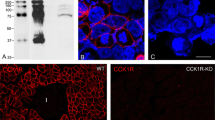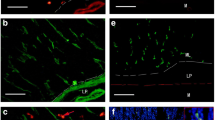Abstract
The present study was undertaken to observe the binding sites of lafutidine, a newly invented H2 receptor antagonist ((+/-)-2-(furfurylsulfinyl)-N-[4-[4-(piperidinomethyl)-2-pyridyl]oxy-(Z)-2 butenyl] acetamide), in the Mongolian gerbil and human gastric mucosa using unfixed cryostat section or incubation with aqueous solution of tritiated lafutidine, followed by in vitro autoradiography or autoradiography of soluble compounds. The localization of calcitonin gene-related peptide immunoreactivity was compared with the lafutidine binding sites. As a result, lafutidine-specific binding sites in the body of the fundic glands were accumulated on the parietal cells, while in the neck and base of the fundic glands, lafutidine was found to bind to the CGRP immunoreactive nerves. In the human fundic mucosa, the lafutidine bindings were also observed on the enteric nerves as well as the parietal cells. In conclusion, autoradiographic studies have shown that lafutidine effector sites coincided with the CGRP-immunoreactive nerves as well as the parietal cells.
Similar content being viewed by others
REFERENCES
Fukushima, Y., Otsuka, H., Ishikawa, M., et al. (2001). Potent and long-lasting action of lafutidine on the human histamine H(2) receptor, Digestion 64, 155–160.
Kato, S., Tanaka, A., Kunikata, T., et al. (2000). Protective effect of lafutidine against indomethacin-induced intestinal ulceration in rats: relation to capsaicin-sensitivesensory neurons, Digestion 61, 39–46.
Nagata, T., Nawa, T. and Yokota, S. (1969). A new technique for electron microscopic dry-mounting radioautographyof soluble compounds, Histochemie 18, 241–249.
Nakamura, M., Akiba, Y., Kishikawa, H., et al. (1998). Effect of combined administration of lansoprazole and sofalcone on microvascular and connective tissue regeneration after ethanol-induced gastric mucosal damage, J. Clin. Gastroenterol. 27, S170–S177.
Onodera, S., Shibata, M., Tanaka, M., et al. (1995). Gastroprotective activity of FRG-8813, a novel histamine H2-receptor antagonist, in rats, Jpn. J. Pharmacol. 68, 161–173.
Onodera, S., Shibata, M., Tanaka, M., et al. (1999). Gastroprotective mechanism of lafutidine, a novel anti-ulcer drug with histamine H2-receptor antagonistic activity, Arzneimittelforschung 49, 519–526
Tani, N., Miyazawa, M., Miwa, T., et al. (1999). Immunohistochemical localization of calcitonin gene-related peptide in the human gastric mucosa, Digestion 60, 338–343.
Umeda, M., Fujita, A., Nishiwaki, H., et al. (1999). Effect of lafutidine, a novel histamine H2-receptor antagonist, on monochloramine-inducedgastric lesions in rats: role of capsaicin-sensitivesensory neurons, J. Gastroenterol. Hepatol. 14, 659–865.
Rights and permissions
About this article
Cite this article
Nakamura, M., Akiba, Y., Matsui, H. et al. Autoradiographic and confocal laser microscopic observation show lafutidine binds to CGRP-immunoreactive nerves as well as gastric parietal cells. Inflammopharmacology 10, 495–503 (2002). https://doi.org/10.1163/156856002321544954
Issue Date:
DOI: https://doi.org/10.1163/156856002321544954




